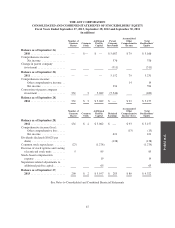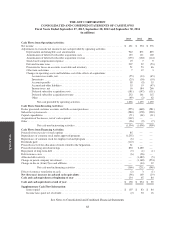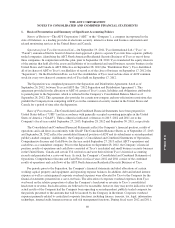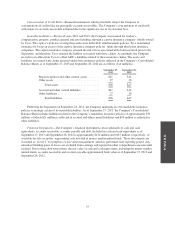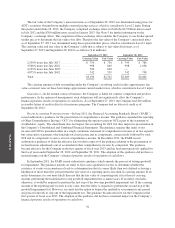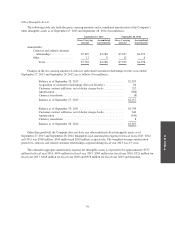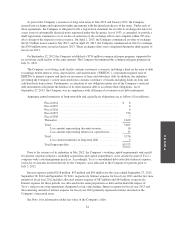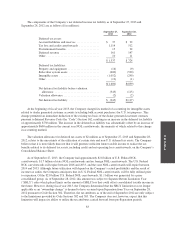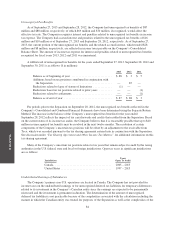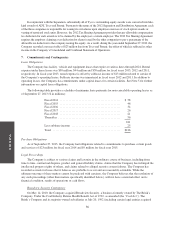ADT 2013 Annual Report Download - page 141
Download and view the complete annual report
Please find page 141 of the 2013 ADT annual report below. You can navigate through the pages in the report by either clicking on the pages listed below, or by using the keyword search tool below to find specific information within the annual report.
FORM 10-K
In July 2012, the FASB issued authoritative guidance which amends the process of testing indefinite-lived
intangible assets for impairment. This guidance permits an entity to first assess qualitative factors to determine
whether the existence of events or circumstances leads to a determination that it is more likely than not (defined
as having a likelihood of more than fifty percent) that the indefinite-lived intangible asset is impaired. If an entity
determines it is not more likely than not that the indefinite-lived intangible asset is impaired, the entity will have
an option not to calculate the fair value of an indefinite-lived asset annually. The guidance became effective for
the Company in the first quarter of fiscal year 2013. The adoption of this guidance did not have a material impact
on the Company’s financial position, results of operations or cash flows.
In February 2013, the FASB issued authoritative guidance which expands the disclosure requirements for
amounts reclassified out of accumulated other comprehensive income (“AOCI”). The guidance requires an entity
to provide information about the amounts reclassified out of AOCI by component and present, either on the face
of the income statement or in the notes to financial statements, significant amounts reclassified out of AOCI by
the respective line items of net income but only if the amount reclassified is required under GAAP to be
reclassified to net income in its entirety in the same reporting period. For other amounts, an entity is required to
cross-reference to other disclosures required under GAAP that provide additional detail about those amounts.
This guidance does not change the current requirements for reporting net income or OCI in financial statements.
The guidance is effective for the Company in the first quarter of fiscal year 2014. The adoption of this guidance
is not expected to have a material impact on the Company’s financial position, results of operations or cash
flows.
In July 2013, the FASB issued authoritative guidance which amends the guidance related to the presentation
of unrecognized tax benefits and allows for the reduction of a deferred tax asset for a net operating loss
carryforward whenever the net operating loss carryforward or tax credit carryforward would be available to
reduce the additional taxable income or tax due if the tax position is disallowed. This guidance is effective for
annual and interim periods for fiscal years beginning after December 15, 2013, and early adoption is permitted.
The adoption of this guidance is not expected to have a material impact on the Company’s financial position,
results of operations or cash flows.
2. Acquisitions
Dealer Generated Customer Accounts and Bulk Account Purchases
During fiscal years 2013, 2012 and 2011, the Company paid $555 million, $648 million and $581 million,
respectively, for customer contracts for electronic security services. Customer contracts generated under the ADT
dealer program and bulk account purchases during fiscal years 2013, 2012 and 2011 totaled approximately
453,000, 527,000 and 491,000, respectively.
Acquisitions
On October 1, 2012, the Company completed the acquisition of Absolute Security, which had been an ADT
authorized dealer, with $16 million of cash paid during fiscal year 2013. As part of this acquisition, the Company
recognized $20 million of goodwill. On August 2, 2013, the Company acquired all of the issued and outstanding
capital stock of Devcon Security Holdings, Inc. (“Devcon Security”) for cash consideration of $146 million, net
of cash acquired. Devcon Security provides alarm monitoring services and related equipment to residential
homes, businesses and homeowners associations in the United States. As part of this acquisition, the Company
recognized intangible assets of $84 million in customer relationships and $60 million of goodwill as well as
insignificant amounts of net working capital and tangible assets. The amounts of revenues and earnings for
Devcon Security included in the Company’s results of operation for the two months ended September 27, 2013
were immaterial. The purchase price allocation for the Devcon Security acquisition is preliminary and remains
subject to post-closing adjustments.
These acquisitions were not material to the Company’s financial statements. There were no acquisitions
made by the Company during fiscal years 2012 and 2011.
77


